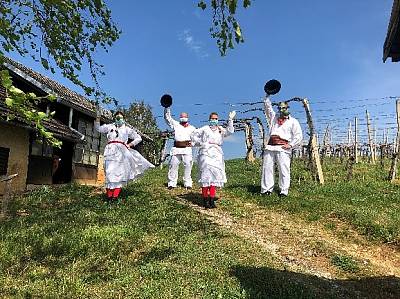Due to the COVID-19 pandemic, in some cases the bearers of the elements listed in the national Register of the Intangible Cultural Heritage of Slovenia have adapted their activities, particularly their festive customs, to the new situation. Here are some examples:
Easter dances and games usually take place on Easter Monday in the medieval center of the town of Metlika.
They involve the folk dance known as the kolo (circle dance) and local games. For example, folklore dancers who dance in Metlika on Easter Monday this year performed the Easter dance in such a way that each dancer or dance couple danced in front of their house.
The music was played through loudspeakers so that all the dancers could hear it. Godbeništvo refers to the social activity of musicians in brass bands involving wind, brass and percussion instruments.
This kind of activity is widespread around the whole of Slovenia and has a long tradition. Musicians who play in different brass bands usually walking through the towns on the morning of May 1 with a vigil, this year performed the vigil in some places during the pandemic by driving fire cars across the town and playing the recorded vigil using speakers.
Walk on the Path of Remembrance and Comradeship is a mass recreation event which takes place in remembrance of the uprising of the people of Ljubljana against the occupier in World War 2.
Every year a mass walk is held following the route of the barbed wire fence and bunkers that the Italian occupiers used to encircle the city from 1942 to 1945.
This year the event was canceled, but some hikers still attended. They registered at checkpoints with the help of a special application on their phones or they were able to put their own stamps at collecting cards.
Las designaciones utilizadas y la presentación de los textos y documentos presentados en esta plataforma no suponen ninguna toma de posición por parte de la UNESCO acerca de la condición jurídica de los países, territorios, ciudades o zonas ni respecto al trazado de sus fronteras o límites.
